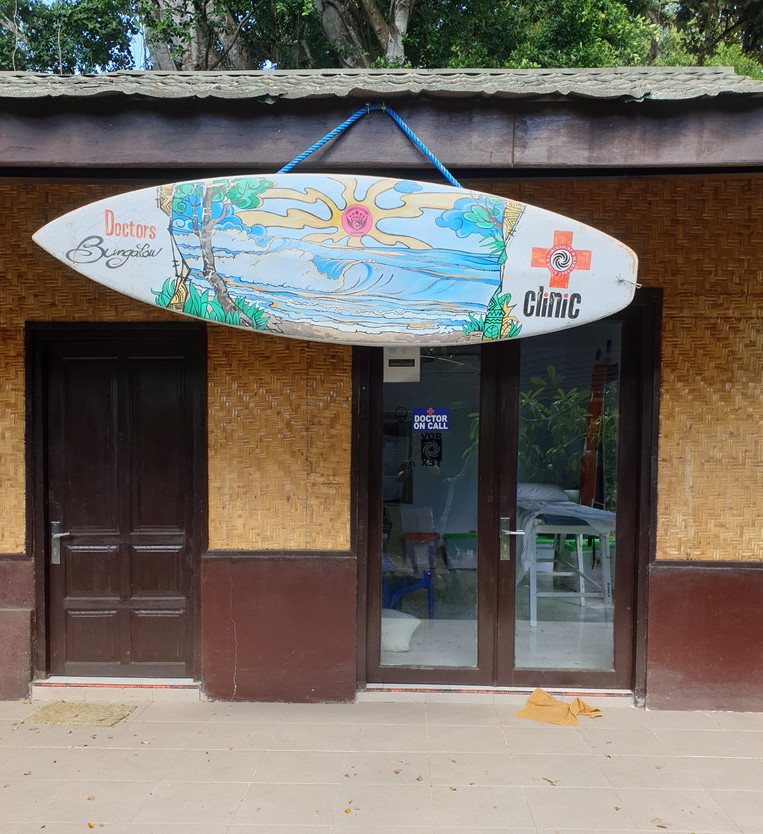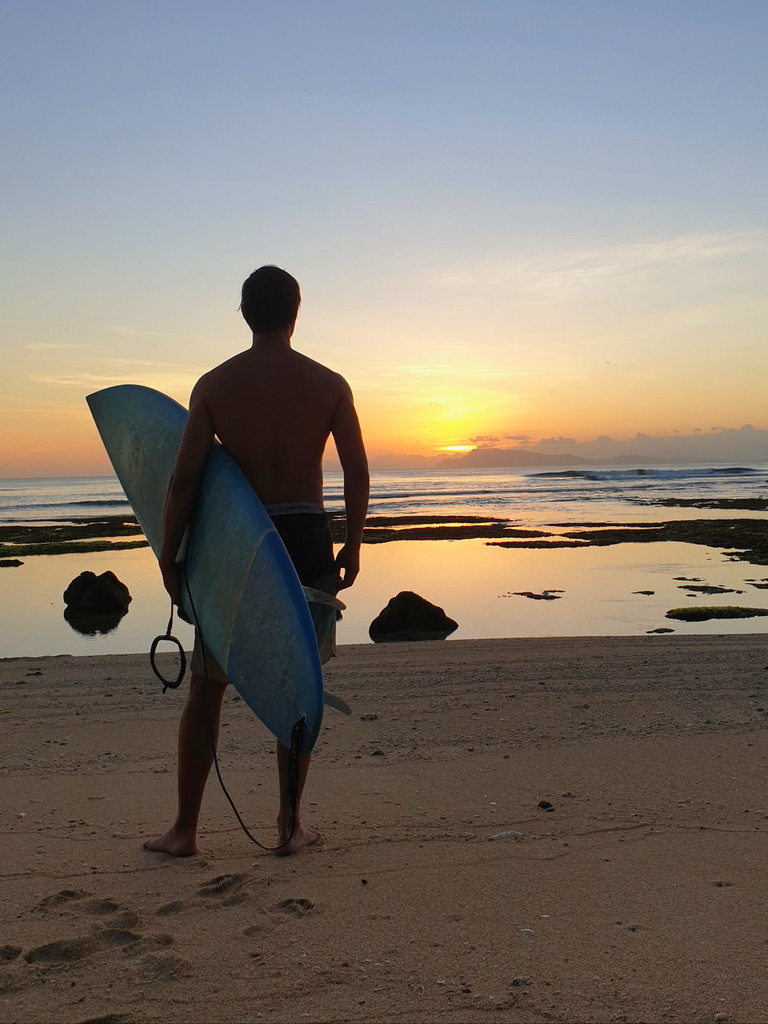Dr. Rogier Steins/General Practitioner/Utrecht, The Netherlands
Rogier shares his journey from skateparks in Utrecht to surf medicine in Indonesia. He puts his qualifications to the test staffing one of the most remote surf clinics in the world, renowned for its formidable waves and furtive monkeys.
G-land, situated on the Eastern side of the Bay of Grajagan in Java, Indonesia, is home to internationally renowned left-handers and some of the biggest surf competitions in the world. But, G-land’s surfing credentials come at a cost: waves ranging from 2-20+ feet, shallow coral reefs and its remote location also produce some of the most dangerous surfing conditions in the world. Working as a surf doctor is not something that is taught at medical school, but for those that are interested, there are definitely ways to get started.
Why Surfing?
As a young kid, I was really passionate about skateboarding. I was addicted to the physical rush it gave me to land a new trick. I would literally eat, sleep, go to school, skateboard and repeat. Five years later, I was starting medical school and saying goodbye to the passion that had brought me so much joy. Thankfully, this would not turn out to be a definitive farewell from board sports.
During my time at university, I joined the board sports student association and tried snow-kiting, surfing and wakeboarding. I realised that I loved surfing. It was not just the physical rush of catching a great wave, but also the serenity of being out in the water that I fell in love with.
Training as a Surf Medic
I came across a group, back then called the European Association of Surfing Doctors (EASD), which spiked my interest immediately. EASD, now known as Surfing Medicine International (SMI), was founded as a non-profit organisation to connect doctors with a passion for surfing. SMI aims to contribute to the health of the surfer by developing surf medicine.
I joined SMI’s Advanced Surfing Life Support (ASLS) course in Ericeira, Portugal. It was great to meet like-minded doctors with an interest in practising medicine outside of the clinical environment. Our days were filled with lectures about topics from drowning to dive medicine, to infectious diseases and heat stroke. The workshops focussed on hands-on scenarios such as CPR, evacuating an injured patient and C-spine immobilisation. Following the acronym DR. MARCH (Danger, Response, Massive haemorrhage, Respiration, Circulation, Hike vs Helicopter/Hypothermia vs Hyperthermia) we had to assess and treat the simulated patient. This might seem similar to an Advanced Wilderness Life Support (AWLS) course but there was one big difference; lifeguarding is also an integral part of the course. How would you get an unconscious surfer on to your board and out of the water as fast as possible?
G-Land
It took me a while to put my training to full use. After graduation, I worked in Emergency medicine and then in surgery, before finishing my training to become a general practitioner. The first thing I did as a fully qualified GP was start my journey to G-Land.
I contacted Surfing Doctors, a non-profit organisation that aims to provide medical care in dangerous and remote surf locations. G-land surf camp is located within the Plengkung Nature Reserve at the edge of Grajagan Bay in Java, Indonesia. Practically, it is a 3-hour fast boat from Kuta, Bali. G-land was discovered by an elite group of surfers in the mid-1970s and is considered one of the best lefts in the world. It produces dangerous surfing conditions that mean reef cuts, infections and trauma can happen in the blink of an eye.
Surfing Doctors has a roster to make sure a doctor is always on-site to provide the necessary medical care. There are three clinics each with basic medical facilities. For more serious injuries, patients are usually evacuated to Bali International Medical Centre (BIMC). BIMC can be reached in seven to ten hours overland, three hours by fast boat, or in more urgent situations, a short helicopter flight.
The Medical Clinic

When I was in G-land, I was the only doctor on site. My first priority on arrival was to visit the clinic and familiarise myself with the medical equipment. The clinic is funded by donations, often from injured surfers who after treatment, can donate to replace the medical equipment that has been used. The most common injuries seen in G-land are reef cuts, sprains and strains. These might seem like minor problems, but even the smallest, most harmless-looking reef cut has a high chance of developing into a serious infection if not treated correctly. This is why antiseptic cream and antibiotics are your best friends in G-land.
Marine life injuries are also common, especially from sea urchins which can leave their mark on a surfer’s foot. The needles are very fragile and can easily break or crush when you’re trying to remove them. On the contrary, shark attacks are really rare; you have a 1 in 63 chance of dying from the flu compared to a 1 in 3.7 million chance of being killed by a shark. Approximately 80 attacks occur worldwide each year, only 5 of which are fatal. To put this in stark perspective, humans kill an astonishing 100 million sharks every year.
Besides marine life, it is also important to be aware of the monkeys that inhabit the surrounding area and jungle. They are accustomed to humans and can transmit rabies through their bite. They are not to be fooled around with, especially the dominant males. At one point they came really close during a yoga session and stole my wallet. Thankfully for me, the only thing bitten was my driver’s licence.
Other common medical problems in G-land include sunstroke, sunburn, malaria, dengue fever and traveller’s diarrhoea. The Indian ocean at G-land can be extremely hostile: major traumatic injuries happen as a result of the enormous power of the waves, with surfers known to have suffered serious pelvic fractures in previous years. Luckily no major incident requiring evacuation occurred during my stay.
The Surf

During my stay, I had enough time to explore the surrounding jungle and catch some waves myself. When surfing anywhere, it is really important to understand and stick to surfing etiquette. It’s also important to respect surf culture and be aware of more unpleasant tendencies like ‘localism’. Surf localism, which I’ve only rarely encountered, is more common in crowded surf spots where locals object to ‘strangers’ catching ‘their’ waves. This mostly consists of verbal assault but has been known to escalate to intimidating signs, physical violence and vandalised equipment. Fortunately, G-land is not a crowded place and the locals were extremely accommodating. A big advantage of being the surf doctor was that a lot of the surfers were happy to see me in the line-up and would often ‘give’ me one of ‘their’ waves.
Surfing terms and etiquette
Right-hander – a wave that breaks to the right from the point of view of the surfer riding the wave. This means that, when looking from the beach towards the ocean, the wave will appear as breaking towards the left.
Line-up – the area where the waves normally begin breaking.
Goofy vs. regular stance – Regular footed means that you surf with your left foot in front: goofy footed people will have their right foot in front
Right of way – the surfer closest to the peak always gets priority. In other words, if you’re paddling for a right-hand wave, and a fellow surfer is on your left shoulder, you must yield to them.
Dropping in – When you disrespect the right-of-way rule above.
Doctor Becomes Patient

Unfortunately, on my last day in G-land I felt really sick. At first, I thought it was just seasickness from the ride on the fast boat back to Bali. Arriving at my hotel, I continued to feel nauseous, developed painful joints and felt feverish. A few hours later, I was vomiting and beginning to get dehydrated. I used some salt and sugar to make my own oral rehydration solution (8 teaspoons of sugar and 1 teaspoon of salt, dissolved in 1 litre of water usually does the trick). As time passed, I began feeling more and more drowsy and decided to head to hospital. I was so weak by this point that I remember struggling not to collapse whilst walking to the taxi. I was afraid I might have malaria or dengue fever but luckily, after a battery of negative tests, we presumed it was just ‘Bali belly’. Thankfully, I made a quick recovery and was able to enjoy the rest of the time I had left in Indonesia.
Top Tips for Working as a Surf Medic:
- Put your own safety first. Don’t go out there and surf in conditions that you are not capable of. Never forget that you are (most likely) the only medical doctor in an incredibly isolated spot and that you need to be in good condition to be able to help others.
- Prepare for the worst. Make sure you know your medical equipment inside out. Get acquainted with the equipment, environment and evacuation procedures as soon as you arrive, so that you don’t lose time when there is a medical emergency.
- Get to know the surfers and get out there. The more you get involved and earn their respect, the sooner they will come to you with a medical problem. It is always easier to treat a medical problem/wound (reef cut) at an earlier stage to prevent the need for evacuation.
More Information and Getting Involved:
- For specific enquiries, Surfing Doctors (glandsurfdocs@gmail.com) have information on current vacancies and opportunities in G-Land.
- The World Conference on Surfing Medicine is a yearly event run by Surfing Medicine International – this year it was in April in Valdovino, Spain. 2024 venue TBA – more information can be found at https://www.surfingmed.com/world-conference-2023/
- Advanced Surfing LIfe Support courses are also run by Surfing Medicine International. Information can be found here https://www.surfingmed.com/smi-live-events/#2









